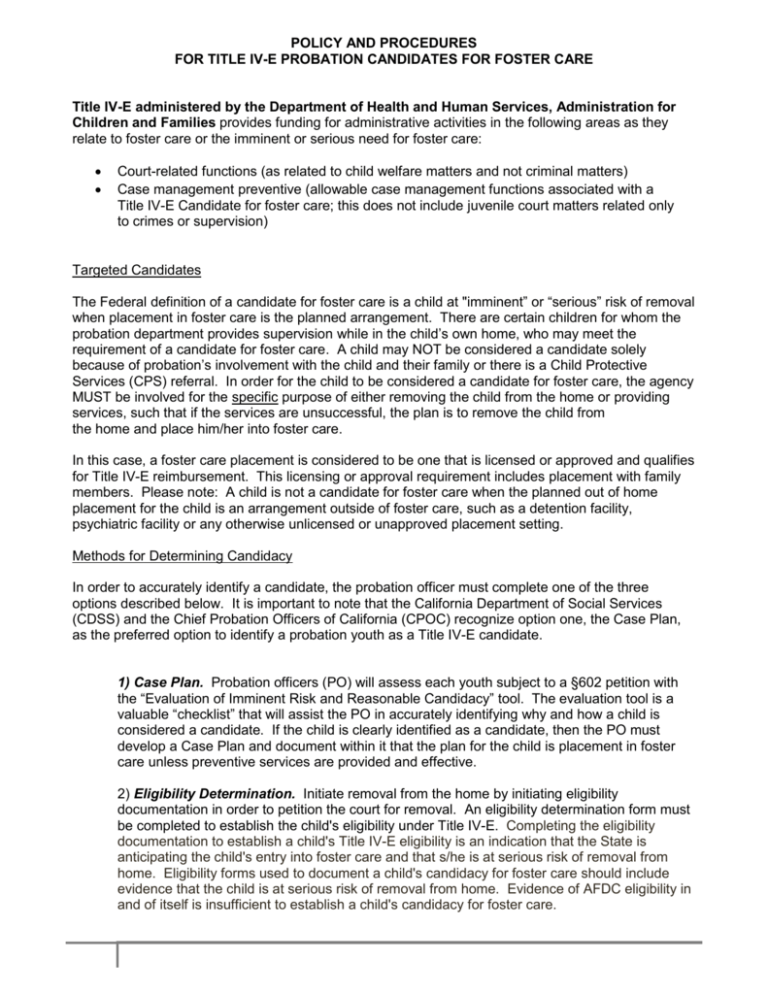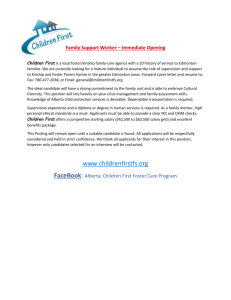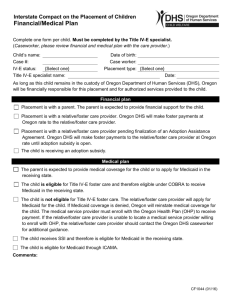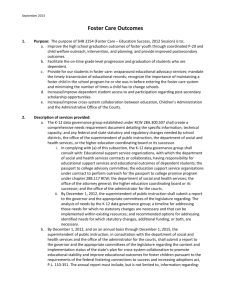Enclosure C: Title IV-E Candidacy Program Policy and Procedures
advertisement

POLICY AND PROCEDURES FOR TITLE IV-E PROBATION CANDIDATES FOR FOSTER CARE Title IV-E administered by the Department of Health and Human Services, Administration for Children and Families provides funding for administrative activities in the following areas as they relate to foster care or the imminent or serious need for foster care: Court-related functions (as related to child welfare matters and not criminal matters) Case management preventive (allowable case management functions associated with a Title IV-E Candidate for foster care; this does not include juvenile court matters related only to crimes or supervision) Targeted Candidates The Federal definition of a candidate for foster care is a child at "imminent” or “serious” risk of removal when placement in foster care is the planned arrangement. There are certain children for whom the probation department provides supervision while in the child’s own home, who may meet the requirement of a candidate for foster care. A child may NOT be considered a candidate solely because of probation’s involvement with the child and their family or there is a Child Protective Services (CPS) referral. In order for the child to be considered a candidate for foster care, the agency MUST be involved for the specific purpose of either removing the child from the home or providing services, such that if the services are unsuccessful, the plan is to remove the child from the home and place him/her into foster care. In this case, a foster care placement is considered to be one that is licensed or approved and qualifies for Title IV-E reimbursement. This licensing or approval requirement includes placement with family members. Please note: A child is not a candidate for foster care when the planned out of home placement for the child is an arrangement outside of foster care, such as a detention facility, psychiatric facility or any otherwise unlicensed or unapproved placement setting. Methods for Determining Candidacy In order to accurately identify a candidate, the probation officer must complete one of the three options described below. It is important to note that the California Department of Social Services (CDSS) and the Chief Probation Officers of California (CPOC) recognize option one, the Case Plan, as the preferred option to identify a probation youth as a Title IV-E candidate. 1) Case Plan. Probation officers (PO) will assess each youth subject to a §602 petition with the “Evaluation of Imminent Risk and Reasonable Candidacy” tool. The evaluation tool is a valuable “checklist” that will assist the PO in accurately identifying why and how a child is considered a candidate. If the child is clearly identified as a candidate, then the PO must develop a Case Plan and document within it that the plan for the child is placement in foster care unless preventive services are provided and effective. 2) Eligibility Determination. Initiate removal from the home by initiating eligibility documentation in order to petition the court for removal. An eligibility determination form must be completed to establish the child's eligibility under Title IV-E. Completing the eligibility documentation to establish a child's Title IV-E eligibility is an indication that the State is anticipating the child's entry into foster care and that s/he is at serious risk of removal from home. Eligibility forms used to document a child's candidacy for foster care should include evidence that the child is at serious risk of removal from home. Evidence of AFDC eligibility in and of itself is insufficient to establish a child's candidacy for foster care. 3) Court Removal. The PO is actively pursuing removal of the child from the home through the court to place the youth in a foster care setting. Evidence of court proceedings in relation to the removal of the child from the home in the form of a petition to the court, a court order or a transcript of the court proceedings are acceptable. If the State agency has initiated court proceedings to effect the child's removal from home, s/he is at serious risk of removal from the home. In order to claim Title IV-E for allowable pre-placement activities, the county must identify and determine that the child meets the candidacy criteria and document the determination. Please note: As referenced earlier, the preferred and most acceptable method of documenting reasonable candidates is the Title IV-E Pre-placement Case Plan. Using the Case Plan to Determine Candidacy When using the Case Plan to determine reasonable candidacy, the PO must identify in the Case Plan the factors that will necessitate removal of the minor from the home unless they are satisfactorily resolved. As a result, the Case Plan shall contain all of the following elements: Description of circumstances including but not limited to behavioral issues that place the child at imminent risk of removal from the home absent the indicated services. This cannot be solely a list of problems, but must include why these issues will result in out of home placement if services are not provided. This will include behavioral issues and obstacles related to the parents or guardian. Types of services needed for the minor to remain safely in his/her home. This may include services aimed at the parents or guardians. Statement that absent the effectiveness of services, foster care is the planned arrangement for the child. A child may enter the probation system and be provided services both formally and informally and not be a Title IV-E candidate. However, at the moment, when a subsequent change or an emerging issue will result in his/her imminent or serious risk of removal from the home and placement in foster care, the PO shall document the reasonable candidacy by completing an “Evaluation of Imminent Risk and Reasonable Candidacy” document and the Title IV-E Pre-Placement Case Plan. Once all required parties have signed the Case Plan, probation may begin claiming Title IV-E administrative costs for eligible activities. There is no maximum length of time a child may be considered a reasonable candidate; however, the PO must complete a new Case Plan every six months while the youth remains a reasonable candidate. The new Case Plan shall document the reasons the child continues to be a candidate. Likewise, if services provided have eliminated the need for a plan that would place the child in foster care, the county must document this in the Case Plan and cease claiming because the child no longer meets the candidate for foster care criteria. In addition, if the six month re-determination of reasonable candidacy is not made (meaning a new Case Plan), the county must stop claiming administrative costs (Social Security Act, section 472(i)(2)). Re-determination shall be updated no less than every six months or as a new change occurs. This will be done by completing both the Title IV-E “Evaluation of Imminent Risk and Reasonable Candidacy” document and a new Case Plan. If a youth is determined to still be a candidate after six months but a new Case Plan has not been completed and signed by all required parties, Title IV-E claiming must cease until the new Case Plan requirement is met. If a child who is in foster care returns home with his parent(s) but circumstances warrant imminent risk of removal again, that child may be considered a candidate for foster care if the criteria mentioned above are met. An “Evaluation of Imminent Risk and Reasonable Candidacy” document and a new Case Plan must be developed that demonstrates the intent to remove the child from home and return him/her to foster care if the pre-placement preventative services fail. It is important to note that all counties need to distinguish between those probation cases identified as candidates for foster care and those probation cases that are not candidates for foster care and report the numbers of each to the State. Counties must develop a form or tracking method to easily identify and track Title IV-E candidates. Important Notes on Case Plan All reasonable candidates must be visited (face-to-face) at a minimum of once per month. Each visit must be documented. When Case Plan goals are accomplished, it should be noted in the Case Plan. Completion of goals that stabilize the child and family may result in the child no longer being a reasonable candidate for foster care. At that point, claiming for Title IV-E administrative costs should stop. Further work with the child would then be documented as “Probation Only” on the time study form. Therefore, counties must be able to identify when the candidacy determination was made but also document when the child no longer meets the candidacy criteria. Case Plans are evolving documents that should be updated and modified as the needs of the child and family change. It is important to maintain the Case Plan as a living document – updating objectives, completion of objectives, and new or emerging issues. The enclosed Case Plan (Enclosure C-1) developed by CPOC has the necessary candidacy language and CDSS strongly encourages the counties to use this Case Plan as the statewide acceptable method of proving candidacy documentation. Case Plans and Claiming Allowable administrative costs may be claimed for activities related to cases where a child is considered a candidate for foster care. Determination of a candidate for foster care is a county probation responsibility. Allowable case management time spent on the case after completion of the Case Plan may be claimed as described in the paragraph below. A county may begin claiming in the same month that the Case Plan is signed by all required parties. It is, therefore, strongly recommended that counties use the Case Plan developed by the CDSS and CPOC (see Enclosure C-1) for easily identifying that a minor has been determined a reasonable candidate. County Probation Departments may begin claiming in the same calendar month that the candidate determination is made IF it is determined the child is a reasonable candidate. The POs will need to document this time and put it on their time study after the determination is made. Note: The Case Plan is the document that determines a youth to be a reasonable candidate. The “Evaluation of Imminent Risk and Reasonable Candidacy” is a tool POs shall use to evaluate each youth on his/her caseload subject to a §602 petition to determine if he or she should take the next step to complete a Case Plan determining reasonable candidacy. SCENARIOS FOR DETERMINING REASONABLE CANDIDATE (Case Management Preventative Services) CANDIDATE FOR FOSTER CARE: On January 5, 2014, John Smith (age 16) was arrested for Assault and Petty Theft. During the investigation process, it was determined John is severely credit deficient, chronically truant, and has been suspended/expelled numerous times for issues related to being under the influence of drugs or alcohol on school grounds and fighting. He admittedly routinely smokes marijuana and methamphetamine and drinks alcohol on a weekly basis. John’s mother has not ensured he comply with his expulsion contact or made any attempt to get him counseling to address his substance abuse or anger issues. Child Protective Services reported 12 referrals wherein John was listed as the victim of neglect and/or abandonment. Two were substantiated with the minor’s mother listed as the perpetrator. The minor’s father’s whereabouts is unknown. As such, Johnny is at imminent risk of placement in a foster care placement specializing in substance abuse. Should he and/or his mother not comply with, or make progress toward the Case Plan objectives, a recommendation for such a placement will be made. NOT A REASONABLE CANDIDATE FOR FOSTER CARE: On January 5, 2014, John Smith (age 16) was arrested for Assault and Petty Theft. During the investigation process, it was determined John is severely credit deficient, chronically truant, and has been suspended/expelled numerous times for issues related to being under the influence of drugs or alcohol on school grounds and fighting. He admittedly routinely smokes marijuana and methamphetamine, and drinks alcohol on a weekly basis. John’s mother ensured he complied with his expulsion contact and made attempts to get him counseling to address his substance abuse and anger issues. Child Protective Services reported 12 referrals wherein John was listed as the victim of neglect and/or abandonment. Two were substantiated with the minor’s father listed as the perpetrator. The minor’s father’s whereabouts is currently unknown. As such, Johnny is not at imminent risk of placement in a foster care placement as his mother is willing and able to continue to provide services for him in the community and will likely benefit from the support of probation supervision. Should the circumstances, issues or obstacles continue, graduated sanctions including juvenile hall could be recommended. The above-referenced reasonable candidate scenarios are not an all-inclusive list of scenarios when determining whether or not certain circumstances meet Title IV-E reasonable candidacy requirements. The scenarios should only be used as a guide to help determine Title IV-E reasonable candidacy eligibility. Reimbursable Title IV-E Administrative Activities Reimbursable Title IV-E administrative activities are limited to the examples provided in 45 Code of Federal Regulations (CFR) section 1356.60(c). Counties are advised to only seek reimbursement for the Title IV-E administrative activities identified in the Department of Appeals Board Decision No. 1428 (1993) which are those activities engaged in after reasonable candidacy has been determined. All the following activities are pre-placement case management services: Referral to Services – providing information to the minor, parent(s) and/or legal guardian(s) or service provider so that the individual can obtain the services. Preparation for and participation in judicial determinations – preparation of reports to the court and participation in court proceedings, except those that are crime and probation only related. Placement of the child –making arrangements for the child’s placement. It also includes discussions with agencies, parents, and foster parents regarding the need for and availability of placement. Updating a Case Plan – This activity is related to the development of the Case Plan, as defined in 42 United States Code 675. Case reviews – evaluation of the continuing needs and services of the child that is completed at least once every six months. Case management and supervision –management/monitoring of the case for services provided to or on behalf of protected children. Example would be a visit to a child in his home or the steps taken by the case manager/monitor to ensure that the case service plans are adequately established and implemented in accordance with service requirements. Data collection and reporting – Activities associated with the preparation and maintenance of applications, authorizations, or any other required child welfare system data/documentation. Non-Reimbursable Activities Any activity in out of home placement shall not be claimed as a pre-placement activity and instead should be claimed as a placement activity. According to 45 CFR section 1356.60(c)(3) and ACYF-PA-87-05, allowable administrative costs do not include the direct provision of services which provide treatment to the child, the child’s family or foster family to resolve personal problems, behavior or home conditions. Examples of non-reimbursable services are: physical or mental health examinations, homemaker or housing services, counseling, and any other direct services to assist in preventing placement and reuniting families. Other non-allowable costs include: “Arranging” for services – arranging activities which are performed on behalf of an individual are not an allowable activity. Any Direct service and counseling are not allowable costs. Staff performing these activities should claim this time to Probation Only. All activities performed on behalf of a reasonable candidate while that child is in custody – activities performed on behalf of a former reasonable candidate now in custody should be allocated to Probation Only. Probation only activities--For example, a PO appearing with a child at a court hearing because the child was accused of a crime and the purpose of the hearing was to address the allegations of the crime committed by the child. PERIODIC TITLE IV-E REVIEWS In order to insure compliance with Title IV-E laws and regulations, a review of program documentation and process will be completed by CDSS on a random basis. Any County found to be out of compliance shall cease claiming immediately and not claim again until a corrective action plan approved by CDSS is in place.





